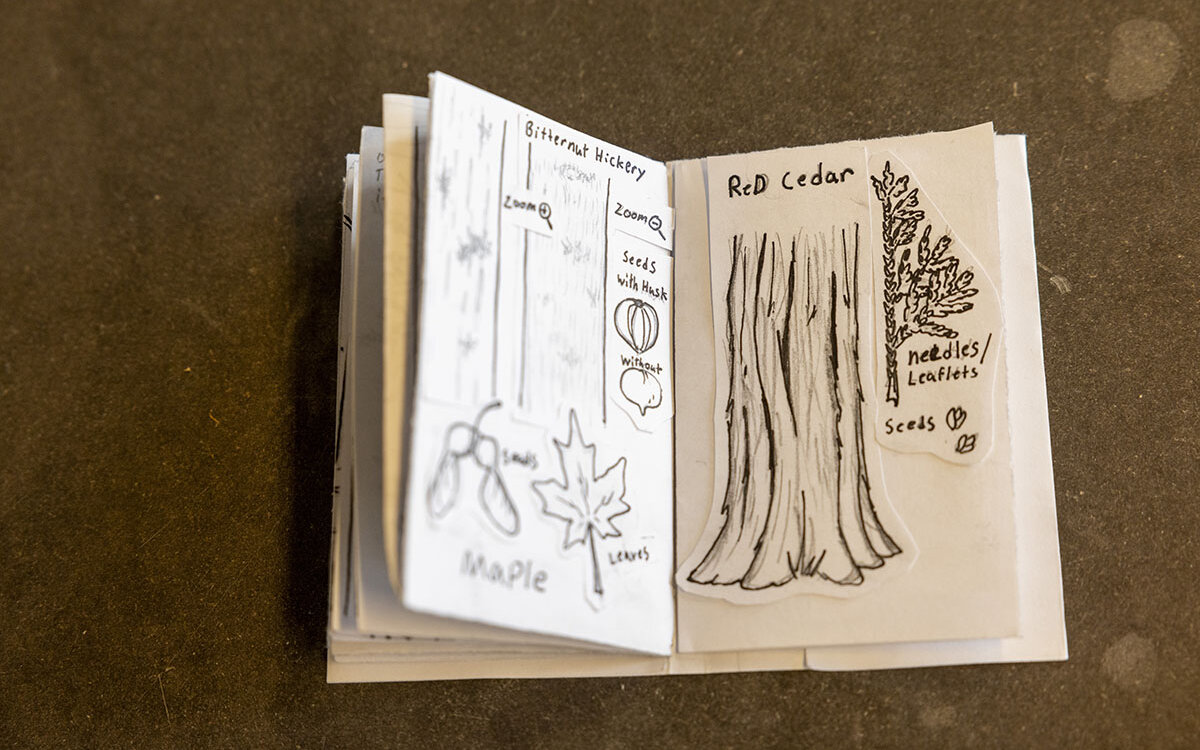Presenting the Forest

On the final Wednesday of the fall 2023 term, students in faculty member Caitlin McDonough MacKenzie’s How to Build a Forest course prepared to present their final projects.
All term, they had worked in teams of four to study a plot of land with a 10-meter radius. They learned the tools and concepts used to evaluate their plots from an ecological perspective. Students identified, measured, and tagged trees; tested soil; surveyed species of plants in the understory; and mapped their data. They cataloged the forest structure and biodiversity in each plot.
“They got to know that 10 m-radius circle of the forest very well,” said MacKenzie.
In addition, each group entered their data and ran analyses. They made histograms of the species richness and tree size classes. Students also read from what MacKenzie calls the “greatest hits” of ecology writing for the popular audience. But the reading, rigorous observation, and data collection and presentation were only part of the work.
The final project challenged students to synthesize their class experiences and share them with a chosen audience in the manner of their choice. The open-ended project required them to use their data and references to the readings but allowed them to use skills developed in other disciplines, like visual arts, sound design, and literature.
“The combination of structure and freedom directed students to create an authentic dialogue between themselves and the forest ecology work that they completed,” said MacKenzie. “This gave them the space to build a personal project, and hopefully the process was meaningful and reflective.”
The results were impressive. Students made podcasts, blogs, paintings, and sculptures. They wrote letters and essays. Each piece of final work included details of local forest ecology that could be determined only through intense observation and data collection.
Sofia Condodemetraky ’27 made a small hand-illustrated book, including a map of the plot she shared with her group mates, the tools they used, acronyms they learned, and the species present.
“This is how I best present things,” Condodemetraky said. “I like to show visuals because that is how I learn.”
Similarly, Rey Cordero ’27 used digital tools to make an illustrated guide.
“It follows the adventure of us,” Cordero said as she presented. She added, “It was an opportunity to share about the amazing forest that we have on campus from your own eyes in your own way. It gave me the chance to do something I’ve always wanted to do and that I didn’t know I was capable of.”
Other members of her group, those who worked cooperatively to study the same plot of land, included students who presented their final work in the form of a blog and a mixed media painting.
“I love how the projects from different students who worked on the same plot approached the forest from different directions. The variety in formats and intended audiences, but also just the perspectives of individual students, meant that each project was a fresh view on the landscape,” MacKenzie said. “Bundling the four projects tied to a specific plot gives this magical, overlapping experience of knowing the forest in different ways.”
The class was a reflection of how ecology work unfolds in the real world.
“In ecology, we build research teams with overlapping and different expertise to catch ecological relationships that one scientist alone might miss,” said MacKenzie.
Among the most extensive and detailed presentations were a podcast by Abby Noel ’27 and a blog, including action shots of the fieldwork, by Harper McDowell ’24.
“The projects were so creative and so thoughtful in part because they are Bennington students, and the ability to reach across disciplines is already second nature to them.” MacKenzie said.
Morgana Moir ’26 filmed the creation of a piece of artwork based on their plot. Throughout the video, the audience could see the work, which used natural materials from the plot itself, come together. Moir also included insights from assigned reading, facts they had learned, and how factors they observed influence their understanding of the forest’s history and its future.
“Morgana’s work is an amazing example of a student synthesizing the course readings and pulling concepts from across our term together,” MacKenzie said.
Among the things she hopes her students came to know about forest ecology is that it's about more than measuring trees.
“Forest ecologists don’t stop with writing numbers on a datasheet; their work extends beyond the data to reach the broader world,” MacKenzie said. “Forest ecology as a field is full of super talented multi-hyphenate people who produce amazing research and great peer-reviewed papers but also create public communications through popular books and podcasts, like those we read and listened to in class, or artwork or collaborations. The data is not enough; they need to be able to communicate the results in real, meaningful ways. My students definitely exceeded this expectation.”
“It was one of my favorite classes of the semester,” said Cordero. “It challenged me in unexpected ways, and I learned a lot about the forest and about myself.”